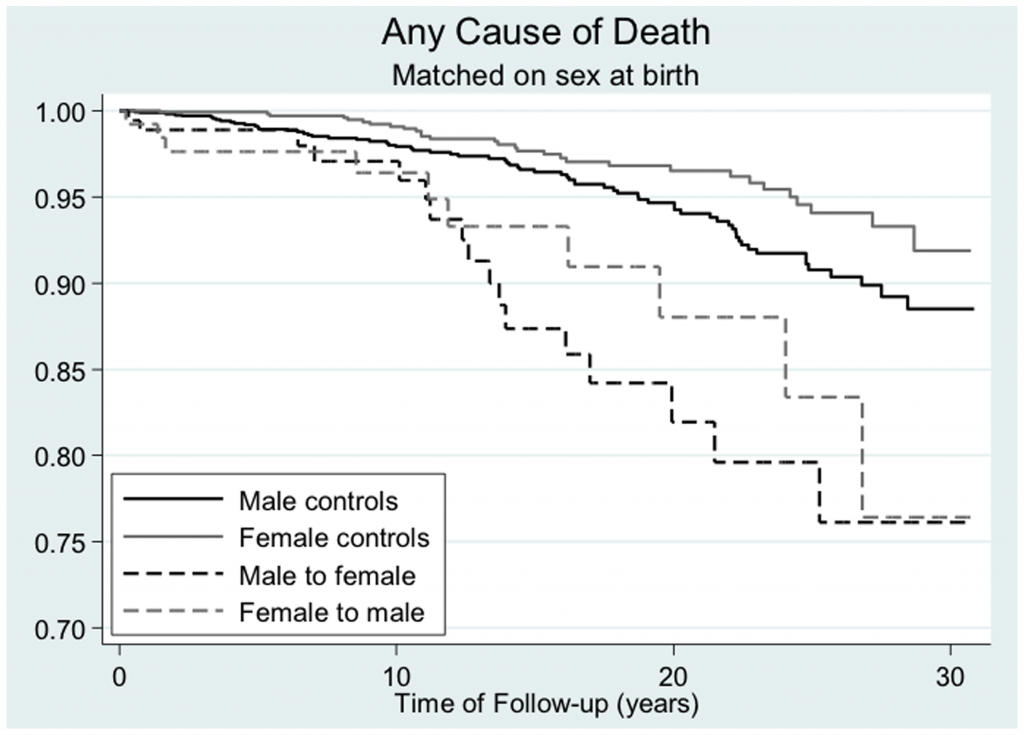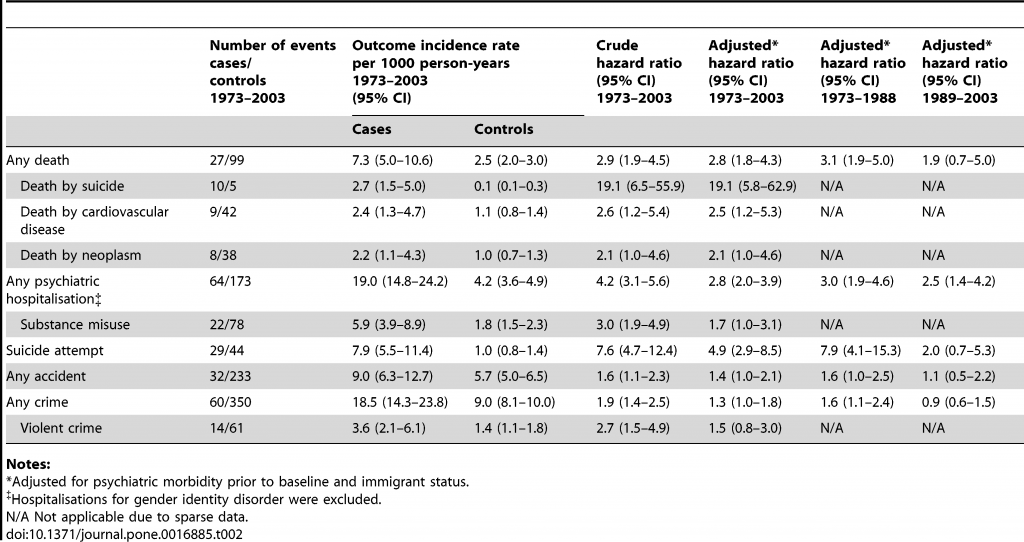Transgender Mortality Rates
Following our discussion of transgender issues last week, I’ve been looking at some research on post-transition outcomes. I’ve found this fascinating study on mortality rates “post-op” (Dhejne et al (2011); Long-Term Follow-Up of Transsexual Persons Undergoing Sex Reassignment Surgery: Cohort Study in Sweden; PlosOne 6:2 e16885).
We report on the first nationwide population-based, long-term follow-up of sex-reassigned transsexual persons. We compared our cohort with randomly selected population controls matched for age and gender. The most striking result was the high mortality rate in both male-to-females and female-to males, compared to the general population. This contrasts with previous reports (with one exception) that did not find an increased mortality rate after sex reassignment, or only noted an increased risk in certain subgroups. Previous clinical studies might have been biased since people who regard their sex reassignment as a failure are more likely to be lost to follow-up. Likewise, it is cumbersome to track deceased persons in clinical follow-up studies. Hence, population-based register studies like the present are needed to improve representativity.
The poorer outcome in the present study might also be explained by longer follow-up period (median. 10 years) compared to previous studies. In support of this notion, the survival curve (Figure 1) suggests increased mortality from ten years after sex reassignment and onwards. In accordance, the overall mortality rate was only significantly increased for the group operated before 1989. However, the latter might also be explained by improved health care for transsexual persons during 1990s, along with altered societal attitudes towards persons with different gender expressions.
What the researchers found was that those men and women who had undertaken transformative surgery had a much lower life-span than the equivalent population. Previous research hadn’t looked at such a long outcome as this piece of research, so it had missed the long-term effect.
Here’s some of the data from the research.
 This is a mortality curve showing the percentage of the original population still living at x years after original operation. You can see the general observation that more men die earlier than women, and this pattern is repeated for those who were pre-op males (so post-op female). But the staggering thing of course is how after ten years or so the mortality rates rapidly increase for those who have undertaken transition surgery.
This is a mortality curve showing the percentage of the original population still living at x years after original operation. You can see the general observation that more men die earlier than women, and this pattern is repeated for those who were pre-op males (so post-op female). But the staggering thing of course is how after ten years or so the mortality rates rapidly increase for those who have undertaken transition surgery.
This next table shows us the odds ratio of dying in different ways when post-op transgendered compared to normal population.
 OK, how to read this table. The first column after the types of death and other events shows how many people died of the different causes in the cases (transgender post-ops) and controls (matched equivalent rest of population). The next two columns tell you the incidence rates among cases and controls (and the confidence intervals for the full population). There then follows crude and adjusted (adjusted to adapt for immigrant status and prevailing psychiatric conditions). It’s the adjusted figures which are the ones to look at. Note also that the populations are further split in two – those who had surgery prior to 1989 and those from 1989 afterwards. The contrast is striking.
OK, how to read this table. The first column after the types of death and other events shows how many people died of the different causes in the cases (transgender post-ops) and controls (matched equivalent rest of population). The next two columns tell you the incidence rates among cases and controls (and the confidence intervals for the full population). There then follows crude and adjusted (adjusted to adapt for immigrant status and prevailing psychiatric conditions). It’s the adjusted figures which are the ones to look at. Note also that the populations are further split in two – those who had surgery prior to 1989 and those from 1989 afterwards. The contrast is striking.
For there to be a significant difference between the cases and the controls, we need to see a hazard ratio above 1 AND we need to see the bottom end of the confidence interval (CI)Â of the hazard ratio. Look at the “Any Death” figures for the full population. The hazard ratio is 2.8 and the bottom end of the CI is 1.8, so we say that there is a statistically significant greater likelihood of death if you are a post-op transgender as opposed to a general member of the population. But look at the sub-populations. The pre-1988 population still shows a statistically significant difference (3.1, 1.9 lower CI), but the post-1989 population has a much lower bottom end to the CI (0.7), so even though the hazard ratio is 1.9, we cannot say with certainty that is a true difference to the controls.
Obviously something happened post-1989, and the paper has some ideas, mainly to do with better health care and improved societal acceptance. The better health care certainly seems to cover the physical deaths, but note that the only statistically significant increase for the post-1989 group was psychiatric hospitalisation – 2.5 (1.4 – 4.2) – and even though this was a reduction from the pre-1988 group it wasn’t of the order of the other reductions.
Here’s the survey’s final conclusion.
This highlights that post surgical transsexuals are a risk group that need long-term psychiatric and somatic follow-up. Even though surgery and hormonal therapy alleviates gender dysphoria, it is apparently not sufficient to remedy the high rates of morbidity and mortality found among transsexual persons. Improved care for the transsexual group after the sex reassignment should therefore be considered.
And that leaves us with a curious question still to be answered – is the higher rate of psychiatric hospitalisation simply due to societal-imposed (and self-imposed) neurosis or is there something intrinsic to those who are transgendered that means that they will have higher rates of psychiatric disturbance regardless of how affirming the environment they are in? Remember, the research is on Swedish post-ops and Scandinavia is arguably one of the most liberal and affirming parts of western society.
The research doesn’t answer that question, but it does tell us very clearly the simple fact that despite the advances in surgery and societal support, post-op transgenders are still far more likely to undergo psychiatric hospitalisation than the general population.
Peter, I haven’t seen original and this just quick comment. The striking finding here is the overall raised death rate due to suicide with hazard ration of 19 isn’t it. This is after the transitioning and surgery remember. Even with the painfully small numbers, that is really very striking. It’s not possible to subdivide those by year but, as the attempted suicide rate appears to have fallen, then this is possible, perhaps probable here also. That would be good news for the folk involved and very welcome but hard to say on the basis of these data.
Even where confidence intervals are reasonable we do need to bear in mind how small numbers are in this study – we are talking about just 27 deaths in the transgender group for the whole study.
I was struck, as you were, by the raised rates of psychiatric admissions. This isn’t, as you suggest, a ’cause of death’ but they are simply presenting the rates of psychiatric admission in the period under study. Although they adjust for psychiatric morbidity at baseline (using what measure??) it’s still not possible to know whether rates increased compared with those in the years preceding the transitioning events, at least from what we have here. But overall, as you say, the rates don’t appear to have fallen and the CI’s overlap widely. Of course numbers may be too small to show a statistical difference if there is one, but the jury is certainly still out on whether there has been a drop in mental health problems overall (particularly as hospital admission is a problematic measure of morbidity anyway).
I suspect that in response to your final question, it’s likely to be a bit of both, in that mental health problems are higher in this group before surgery so that will contribute to the on-going picture as well as adjustment problems after the surgery. Although before and after surgery comparison data are not presented here, the question of why there is no evidence of a marked improvement in problems after surgery seems to remain. That is part of the aim – to improve overall mental health. But to repeat – I haven’t seen all the data, so there may be other factors to take into account. Best . Glynn
This isn’t, as you suggest, a ’cause of death’ but they are simply
presenting the rates of psychiatric admission in the period under study.
Oopps – yes my bad. Quick edit….
The striking finding here is the overall raised death rate due to suicide with hazard ration of 19 isn’t it
Do you mean psychiatric hospitalisation? The suicide rate HR is 7.9.
I take your point about the CIs but even though they are pretty wide (small sub-samples as you say) they’re still way above the 1:1 ratio. I think we’re clear the results are statistically significant on an overall (1973 to 2003) level.
No I mean the death by suicide rate. The attempted suicide rate is 7.9. Perhaps this better over a pint and the original paper in hand! thanks for drawing folks attention to it, because whatever issues we might want to debate, clearly there is a lot of uncertainty about what is going on here that’s not simply resolved with cosmetic surgery. And as I say, really encouraging that death rates from medical conditions do seem to be falling overall.
Aaaahhhh…..
Interestingly we don’t have the sub-samples for the pre and post 1988 splits, but regardless yes you’re right that the HR is astonishing.
And this feeds into my final point. Is this mental health issue simply down to societal approval (or lack of it) or does it indicate that gender dysphoria is itself linked to wider mental health issues.
We need more research…